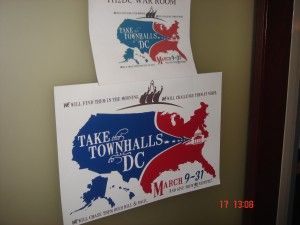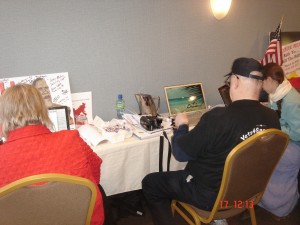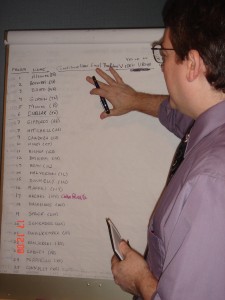Inside the Tea Party War Room
 While the media focused their attention on the small colorful gathering of anti-health bill protesters Tuesday, at another location on the Hill, a small group of activists had set up a war room to better organize and mobilize the tea partiers.
While the media focused their attention on the small colorful gathering of anti-health bill protesters Tuesday, at another location on the Hill, a small group of activists had set up a war room to better organize and mobilize the tea partiers.
Large rallies are the most distracting part of the Tea Party movement. They provide a colorful array of speakers, posters, and period-era costumes for the media to obsess over, while ignoring the movement’s actual legwork. As the March 16th “Kill the Bill” rally was happening, a motley group of activists had set up a Tea Party “War Room” in the Capitol Hill Suites. From this “War Room” they sent organized volunteers to go and pressure vulnerable house Democrats to vote against the healthcare bill. The Tea Party’s ability to organize these activists might be more important than their colorful protests.
The “War Room” had a very different feel from the rally. It was a small and cramped meeting space in the Capitol Hill Suites annex. The most important piece of technology in the room was an easel with a giant pad of paper. On it, they had written up a list of vulnerable house Democrats that volunteers should lobby in their officers (Representative Jason Altmire was top of the list because he announced he was undecided on healthcare.)
The war room crowd was much older and calmer then the rally crowd. This is significant in a movement that is decidedly not a product of the millennial generation. At the rally, there were families with children and people in their thirties, while in the war room the crowd tended to be in their fifties or older, and brought no children. They also were much less eccentric than some of the people at the rally: no one was in period era costume, and no one was waving any "Don’t Tread on Me" flags.
It will remain a great irony for historians that while Organizing for America failed to tap the enthusiasm of the millennials who voted for Obama to win in Virginia, New Jersey, and Massachusetts, the Tea Party was able to cultivate a robust group of middle aged and septuagenarian activists.
In the war room, the activists would file in and get met with friendly help from the organizers. One woman would announce: “If anyone needs help with a press release, I have a template on my laptop” and someone would come over to get help writing a press release about how a New York congressman ignored her. Two men from Maryland would head over to the easel and ask, “What do you suggest we do? We’re just two guys who are from Maryland” (a state with no vulnerable Democrats) and an organizer at the easel would say, “The question is” (while flipping through his chart) “who hasn’t had any visitors today? Connecticut, how about that?”
Tom Whitmore was the grandfatherly figure overseeing the operation. Although calm in demeanor, he was also multitasking between sending out groups and making sure each group had a video camera to capture anything that might be worth putting on YouTube. I asked someone if they knew when Tom would finish and have time for an interview. “Tom will never finish unless you interrupt him” was the response.
Eventually, there was a lull in the volunteers and Tom had time to gleefully explain what they were doing. Tom was bringing order to the chaos of the Tea Party movement, “the job that we have is to teach them how to take that energy, and how to go beyond the movement, how to go beyond the rally and the sign waving and the chanting, and translate that into real change.”
Tom also made clear his positive opinions on the Tea Party’s ability to work with Republicans, saying they had “a natural affinity with the Republican Party... that's why we ask them for some signs, and some buttons and things.” He was part of Michael Steele’s meeting with the Tea Party leaders and had previously blogged on how it was a “wake up call” for the RNC. Though he did say that it was an education for many of the first time Tea Party activists as well, “It was a very fruitful meeting, the RNC learned a lot of things, the Tea Party learned a lot of things. A lot of them [Tea Party activists] didn’t know how this whole electoral process works.”
Tom and his War Room were part of the “Take the Townhalls to Washington” campaign, which in turn is a project of Mark Skoda, a Tea Party organizer who helped run the National Tea Party convention and has been described by some as the Tea Party’s “pragmatist.” Sending volunteers into targeted offices and coordinating media releases is an example of translating the raw emotion of screaming “Kill the Bill” into an actual plan, as Tom put it, “You work with something like this, where you have a plan, and you execute the plan.”
At the Washington Independent, David Weigel notes that the size of the rally was not impressive:
The Code Red rally was small, drawing around 300 people into a noisy circle. So was the FreedomWorks “People’s Surge,” which sent Tea Party activists onto Capitol Hall to seek out one-on-one meetings with members of Congress whose votes could decide the fate of healthcare reform. Both events were mocked for their size, by Democrats and liberal groups that had grown used to explosive media coverage of the conservative movement.
This makes sense, the emotion that inspires people to attend rallies can ebb and flow. In contrast, Tom seemed more committed to the Tea Party vision, he said he was not content when Scott Brown was elected and that he tried to pressure his activist colleagues to keep the pressure up on congress. While he admitted that overall attendance was low, he was still able to see the silver linings, “It wasn’t like past rallies but who would have expected [that]… [for] the other rallies [the April 15th tax day rally and the 9/12 march] they spent six months planning them.”
The Tea Party movement’s long term viability is likely dependent on people who can actually get volunteers to do more then just bring a flag to a rally. Even if attendance was small, its hard to refute the notion that they didn’t achieve anything, “people dropped what they were doing on a two or three day notice -- the rally was only announced three or four days ago -- and our whole effort only started ten days ago.” Even if the healthcare bill does become law, in other measures, the movement may still be enjoying limited success.
Follow Noah on twitter: @noahkgreen





